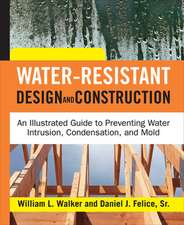Adaptive Cooperation between Driver and Assistant System: Improving Road Safety
Autor Frédéric Holzmannen Limba Engleză Paperback – 19 oct 2010
Based on a cognitive functionality split, execution and command levels are detailed. The execution level centralized over the stability control performs the motion vector coming from the command level. At this level the driver generates a motion vector which is continuously monitored by a virtual co-pilot. The integration of assistance systems in a safety relevant multi-agent system is presented here to provide first an adequate feedback to the driver to let him recover a dangerous situation. Robust strategies are also presented for the intervention phase once the command vehicle has to be optimized to stay within the safety envelope.
| Toate formatele și edițiile | Preț | Express |
|---|---|---|
| Paperback (1) | 941.82 lei 6-8 săpt. | |
| Springer Berlin, Heidelberg – 19 oct 2010 | 941.82 lei 6-8 săpt. | |
| Hardback (1) | 946.24 lei 6-8 săpt. | |
| Springer Berlin, Heidelberg – 19 noi 2007 | 946.24 lei 6-8 săpt. |
Preț: 941.82 lei
Preț vechi: 1148.56 lei
-18% Nou
Puncte Express: 1413
Preț estimativ în valută:
180.21€ • 188.67$ • 149.12£
180.21€ • 188.67$ • 149.12£
Carte tipărită la comandă
Livrare economică 05-19 aprilie
Preluare comenzi: 021 569.72.76
Specificații
ISBN-13: 9783642093883
ISBN-10: 3642093884
Pagini: 240
Ilustrații: XIII, 225 p.
Dimensiuni: 155 x 235 x 13 mm
Greutate: 0.34 kg
Ediția:Softcover reprint of hardcover 1st ed. 2008
Editura: Springer Berlin, Heidelberg
Colecția Springer
Locul publicării:Berlin, Heidelberg, Germany
ISBN-10: 3642093884
Pagini: 240
Ilustrații: XIII, 225 p.
Dimensiuni: 155 x 235 x 13 mm
Greutate: 0.34 kg
Ediția:Softcover reprint of hardcover 1st ed. 2008
Editura: Springer Berlin, Heidelberg
Colecția Springer
Locul publicării:Berlin, Heidelberg, Germany
Public țintă
ResearchCuprins
New concept of cooperation.- Needs of improved assistant systems.- Adaptive cooperation between driver and assistant system.- Executive level as vehicle platform.- Requirements for the executive level.- Road–tire ? friction coefficient estimation.- Actuators and drive train architecture.- Vehicle dynamics model.- Performing the vehicle command.- Virtual driver for the cooperation.- Extended middleware for fault-tolerant architecture.- Agents derived from the robotic field.- Tactic agent for speedway/highway.- Adaptive cooperation.- Methodology of a fault-tolerant adaptive cooperation.- Understanding the driver maneuver.- Determination of the driver drowsiness.- Cooperation at the command level.- Feedback management for the driver and the virtual driver.- Discussion on the proposed concept.- Concept summary and overview of the functionalities.- General conclusion.
Textul de pe ultima copertă
One of the next challenges in vehicular technology field is to improve drastically the road safety. Current developments are focusing on both vehicle platform and diverse assistance systems. This book presents a new engineering approach based on lean vehicle architecture ready for the drive-by-wire technology.
Based on a cognitive functionality split, execution and command levels are detailed. The execution level centralized over the stability control performs the motion vector coming from the command level. At this level the driver generates a motion vector which is continuously monitored by a virtual co-pilot. The integration of assistance systems in a safety relevant multi-agent system is presented here to provide first an adequate feedback to the driver to let him recover a dangerous situation. Robust strategies are also presented for the intervention phase once the command vehicle has to be optimized to stay within the safety envelope.
Based on a cognitive functionality split, execution and command levels are detailed. The execution level centralized over the stability control performs the motion vector coming from the command level. At this level the driver generates a motion vector which is continuously monitored by a virtual co-pilot. The integration of assistance systems in a safety relevant multi-agent system is presented here to provide first an adequate feedback to the driver to let him recover a dangerous situation. Robust strategies are also presented for the intervention phase once the command vehicle has to be optimized to stay within the safety envelope.
Caracteristici
Presents the strategies in vehicle engineering and safety for the next 15 years Demonstrates how to generate vehicles as safe platform within optimized traffic flow Nicely illustrated introductory book to driver assistant systems describes the fusion of sensors and assistant systems to generate a safe vehicle envelope Aggregates synchronisation, electrical wedge brake, steer-by-wire Includes supplementary material: sn.pub/extras














